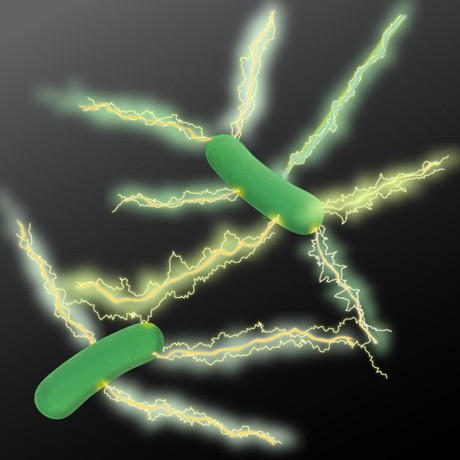Microbial nanowires for green electronics

Microbiologists at the University of Massachusetts Amherst have discovered a type of natural wire produced by bacteria that could greatly accelerate their goal of developing sustainable conducting materials for the electronics industry.
Their research, led by Derek Lovley and published in the journal mBio, saw the scientists study microbial nanowires — protein filaments that bacteria use naturally to make electrical connections with other microbes or minerals. According to Lovley, these nanowires have “substantial advantages over man-made materials”.
“Chemically synthesising nanowires in the lab requires toxic chemicals, high temperatures and/or expensive metals,” said Lovley. “The energy requirements are enormous. By contrast, natural microbial nanowires can be mass-produced at room temperature from inexpensive renewable feedstocks in bioreactors with much lower energy inputs. And the final product is free of toxic components.
“Microbial nanowires therefore offer an unprecedented potential for developing novel materials, electronic devices and sensors for diverse applications with a new environmentally friendly technology,” he added. “This is an important advance in microbial nanowire technology.”
Until now, Lovley’s lab has been working with the nanowires of just one bacterium — Geobacter sulfurreducens — as they were just trying to understand why a microbe would make tiny wires. “Now we are most interested in the nanowires as an electronic material and would like to better understand the full scope of what nature may have to offer for these practical applications,” he said.
When his lab began looking at the protein filaments of other Geobacter species, they were surprised to find a wide range in conductivities. For example, one species recovered from uranium-contaminated soil produced poorly conductive filaments. Another species, Geobacter metallireducens, produced nanowires 5000 times more conductive than the G. sulfurreducens wires, suggesting they may be an attractive material for the construction of conductive materials, electronic devices and sensors for medical or environmental applications.

The researchers noted that they did not study the G. metallireducens strain directly; instead, they took the gene for the protein that assembles into microbial nanowires from it and inserted this into G. sulfurreducens. The result is a genetically modified G. sulfurreducens that expresses the G. metallireducens protein.
“We have found that G. sulfurreducens will express filament genes from many different types of bacteria,” noted Lovley. “This makes it simple to produce a diversity of filaments in the same microorganism and to study their properties under similar conditions.
“With this approach, we are prospecting through the microbial world to see what is out there in terms of useful conductive materials. There is a vast reservoir of filament genes in the microbial world and now we can study the filaments produced from those genes even if the gene comes from a microbe that has never been cultured.”
Hidden semiconductor activity spotted by researchers
Researchers have discovered that the material that a semiconductor chip device is built on,...
3D reflectors help boost data rate in wireless communications
Cornell researchers have developed a semiconductor chip that will enable smaller devices to...
Scientists revolutionise wireless communication with 3D processors
Scientists have developed a method for using semiconductor technology to manufacture processors...










